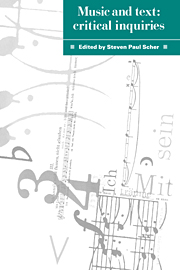Book contents
- Frontmatter
- Contents
- List of figures
- List of contributors
- Preface
- Acknowledgments
- Part I Institutional dimensions and the contexts of listening
- Part II Literary models for musical understanding: music, lyric, narrative, and metaphor
- Part III Representation, analysis, and semiotics
- 8 Music and representation: the instance of Haydn's Creation
- 9 Musical analysis as stage direction
- 10 Poet's love or composer's love?
- 11 The semiotic elements of a multiplanar discourse: John Harbison's setting of Michael Fried's “Depths”
- Part IV Gender and convention
- Index
8 - Music and representation: the instance of Haydn's Creation
Published online by Cambridge University Press: 04 September 2009
- Frontmatter
- Contents
- List of figures
- List of contributors
- Preface
- Acknowledgments
- Part I Institutional dimensions and the contexts of listening
- Part II Literary models for musical understanding: music, lyric, narrative, and metaphor
- Part III Representation, analysis, and semiotics
- 8 Music and representation: the instance of Haydn's Creation
- 9 Musical analysis as stage direction
- 10 Poet's love or composer's love?
- 11 The semiotic elements of a multiplanar discourse: John Harbison's setting of Michael Fried's “Depths”
- Part IV Gender and convention
- Index
Summary
Representation in music has a checkered critical history. To a certain temperament, the musical “painting” of a scene or a process is inevitably naive, best tolerated when it can be overlooked in favor of a self-sufficient musical structure. A hostile contemporary critic of Haydn's Creation had virtually the last word on this subject several years before Beethoven nervously insisted that the Pastoral Symphony is “more the expression of feeling than painting.” “What can one say,” writes the semi-anonymous Herr Triest, “to a natural history or geogony set to music, where the objects pass before us as in a magic lantern; what to the perpetual pictorializing …? Truly, the author of the old Mosaic story of the seven days of creation probably did not dream it would make such a great hit again at the end of the eighteenth century!”
Triest's attitude is proto-formalist; it understands music as a hopelessly poor or ineffable bearer of meaning. First crystallized in Eduard Hanslick's The Beautiful in Music (Vom Musikalisch-Schönen, 1854), the formalist attitude has long – too long – set the terms for serious thinking about music. Those terms embrace a number of skeptical assumptions: that music is radically inferior to language as a medium of discourse; that intelligibility in music rests on a purely “musical” foundation, the working-out of “musical ideas”; that any definite meaning attached to a composition is in principle detachable as “extramusical” – or, if not, that the music is somehow trifling.
Information
- Type
- Chapter
- Information
- Music and TextCritical Inquiries, pp. 139 - 162Publisher: Cambridge University PressPrint publication year: 1992
Accessibility standard: Unknown
Why this information is here
This section outlines the accessibility features of this content - including support for screen readers, full keyboard navigation and high-contrast display options. This may not be relevant for you.Accessibility Information
- 4
- Cited by
